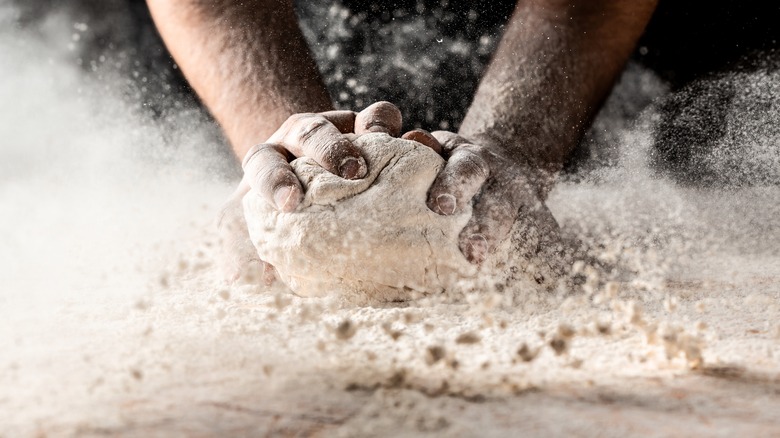Why The Protein Content Of Flour Is So Important
Flour — arguably the most basic and fundamental of all kitchen staples — is quite a remarkable invention for our species. Ancient humans took a plant that, as Cook's Info points out, is inedible in its raw form, and turned it into a global staple. Doing so required the exact kind of ingenuity that set homo sapiens apart from the rest of the animal kingdom. Archaeologists have found starch-coated grinding stones that date back at least 32,000 years, suggesting that flour was born from some of history's first kitchen equipment (via NPR). Yet, despite the millennia-old connection between people and flour, these simple grains still pose a mystery to many.
Particularly troublesome is the question of which type of flour to use for what purpose — a puzzle that goes far beyond the distinction of white versus whole wheat. Can you really use all-purpose flour for all purposes? Could you make a pie crust out of bread flour, or sandwich bread from pastry flour? Who's assigning all these special roles, and why? The answers to all of the above can be found in the flour's protein content, per Epicurious, printed right there on the bag in percentage form. "Protein" is a word we typically associate with meat, not dough products, so the specific role it plays in flour could probably use some elaboration.
Protein equals gluten
The protein content of the flour you use directly relates to the gluten content needed for your baked goods. Gluten refers to a group of proteins that bond to each other, forming a web-like network that provides structural support to your dough. The gluten family includes hundreds of unique proteins, but two are particularly important in baking: gliadin and glutenin. Gliadin impacts a dough's expansibility, that is, how much it will rise, while glutenin is responsible for its elasticity and tensile strength (via ScienceDirect). Together, these proteins have a profound effect on the size, shape, and texture of your baked goods.
As you might have figured out by now, the protein content printed on your bag of flour is really telling you the gluten content. As Epicurious notes, higher levels of protein in your flour will make for a more elastic dough with a strong gluten structure. This is ideal for making sturdy-but-airy loaves of bread, which is why "bread flour" has a higher protein content (typically 12 to 14%) than all-purpose flour (9 to 12%). On the other end of the spectrum, low-protein flours are great for treats with a lighter structure, like cakes and pastries.

